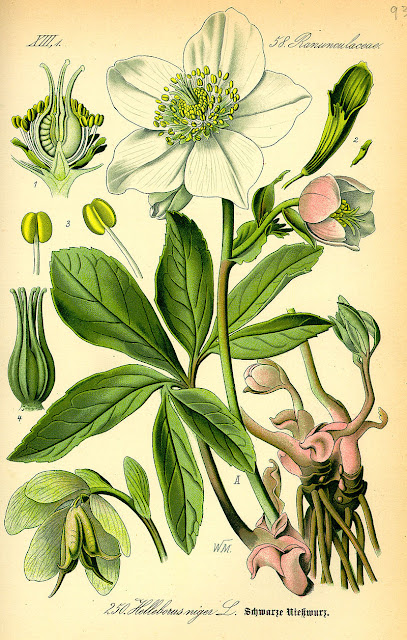 |
| Hellebores and hand pollination |
Hand pollinating is a straightforward, yet fascinating process. Essentially, it is the act of selective hybridization or to put it more simply, a way of trying to create a distinctly new plant which combines chosen characteristics two genetically different parent plants. This is achieved by taking pollen from one plant's anthers and distributing it onto the stigmas of another. However to ensure that ‘rogue’ pollen doesn't makes its way onto your selected stigmas then there are a few tried and tested techniques that can help in achieving hybrid perfection.
All you need to start of with is two good quality and healthy hellebores but don't just choose any old thing. Consider what you want to achieve first and then find two plants that – between them – have the characteristics to give you the best chance of achieving your goal. If your parent plants are indifferent then their progeny will also be indifferent.
 |
| Hellebores and hand pollination |
Traditionally, pollen transfer is made using a small ‘watercolor’ paint brush, but you may wish to try the similar technique of using a new ballpoint pen. Rub the pen lid on your trousers to create some static and then place it close to the anthers. Gently coax the anthers and you will find that the pollen begins to ‘stick’ to the static pen lid. Continue with this until you can see a clear dusting of pollen on the pen lid. Now open up the fat unopened bud from the first parent and stroke the pollen covered pen lid onto its stamen. To prevent further pollen entering the flower by bees or other pollinating insects, cover the flower with a lightweight gauze or, if you have some available, material from an old pair of tights. This will also help to identify which buds on the plant were fertilized by hand so that the seed can be collected from the appropriate seed pods later on in the year.
Make sure however that you clearly label - and perhaps even photograph - everything, because if you want to refine the hybridization with a second generation of seedlings you will need to know their lineage.
There are a number of things that you may also wish to consider with regards to your chosen characteristics and these are listed by the gentlemen at hellebore.org below.
1. Sepal color: When seeking clear colours it makes sense to avoid plants with spotting or veining. Likewise, if the primary interest lies in certain color ranges such as white-yellow or violet-black, then it also makes sense to generally avoid the colors intermediate between them. Generally, to create particular colour lines one would work within the colour groups. Though crossing widely divergent colours can at times create wonderful and interesting shades and combinations, hybrids are notorious for giving 'muddy' results.
2. Sepal shape: If one goal is rounded overlapping sepals, then it makes sense to avoid plants with very pointed, twisted, and star-shaped sepals. Symmetry is an important goal for many breeders. Many, if not most, hellebore flowers have a tendency to show asymmetrical patterns in form and colour. Some of the asymmetry is caused by genetic material responding to environmental factors and can be difficult to control, particularly in the open garden.
3. Flower size/number: Flower size and quantity varies. Some plants have beautiful flowers that are produced sporadically; other plants produce dozens of mediocre flowers in a season. There is scope for producing many decent sized flowers of good color and substance on profuse inflorescence.
4. Nectaries: In recent years, more attention has been given to nectary form and color, and for good reason. Nice nectaries can provide interesting contrast with the background at the base of the sepals. They also seem to play a role in 'doubling' since true nectaries are typically absent in the most common double forms.
5. Bracts/Cauline leaves: The bracts can be very important. They give texture to emerging flower stalks, and they can also have very interesting colouration to match or contrast with the flowers. Plants with small bracts feature the flowers, but larger bracts often give the inflorescence a more substantial appearance.
6. Foliage: Foliage is perhaps one of the most important aspects of hybridizing but often one of the most ignored. Typically it is the species that show the most polymorphic and interesting foliage (this is one reason why it is strange that species are often ignored in programs), but sometimes interesting ranges can be achieved in hybrids as well. Colour, texture, and number and width of divisions are some key things to keep in mind. It is also important to consider whether or not you want foliage that is evergreen because the foliage of many species will die back over winter.
7. Health/Vigor: Sometimes a plant can produce a flower that is just what you want but may be a very weak grower or even prone to fungus or disease. It is our opinion that such plants should be avoided. You may get more vigorous plants from future generations, but there is no guarantee that the plant will make a good parent. Also, allowing weak or diseased plants to remain in your garden potentially increases the chance of pathogens spreading to other plants.
Main image credit - Simon Garbutt https://creativecommons.org/licenses/by-sa/3.0/deed.en
In text image - Public Domain, https://commons.wikimedia.org/w/index.php?curid=8566
For related articles click onto the following links:
HELLEBORUS 'Penny's Pink'







No comments:
Post a Comment